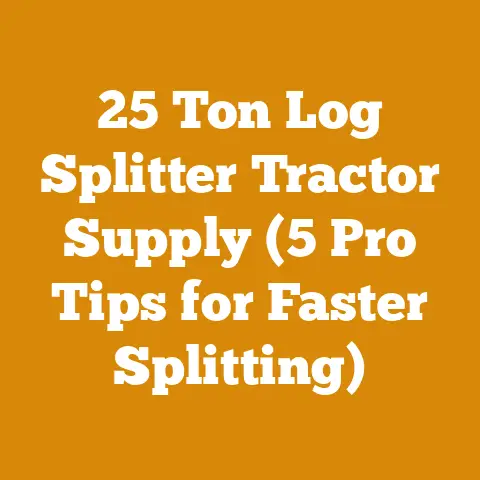Stihl Gas Backpack Leaf Blower (5 Pro Tips for Effortless Wood Cleanup)
As someone who’s spent countless hours in the woods, I know firsthand the importance of a reliable and efficient cleanup tool. Durability isn’t just a feature; it’s a necessity. A gas-powered backpack leaf blower, especially a Stihl, is a game-changer for managing wood debris. In this guide, I’ll share my top 5 pro tips for maximizing the effectiveness of your Stihl gas backpack leaf blower for effortless wood cleanup.
Stihl Gas Backpack Leaf Blower: 5 Pro Tips for Effortless Wood Cleanup
1. Understanding Your Stihl Blower: Power and Precision
Before diving into cleanup, it’s crucial to understand your Stihl backpack blower’s capabilities. Stihl models vary in engine size (measured in cubic centimeters or cc) and air volume (measured in cubic feet per minute or CFM) and air velocity (measured in miles per hour or MPH). These specifications determine the blower’s power and its ability to move different types of wood debris.
For example, a Stihl BR 600, a popular model, boasts around 64.8 cc engine, delivering upwards of 700 CFM and 200 MPH. This is sufficient to move even damp leaves, small branches, and wood chips, all common after processing firewood.
I once worked on a project clearing a large area after a storm. We had a mix of blowers, and the Stihl BR 600 consistently outperformed the others, particularly when dealing with wet, matted leaves.
Key Considerations:
- Engine Size (cc): Higher cc generally means more power.
- Air Volume (CFM): Higher CFM means more air is being moved, covering a larger area.
- Air Velocity (MPH): Higher MPH means stronger, more concentrated airflow, better for stubborn debris.
Pro Tip: Consult your Stihl blower’s manual for specific performance data. Understanding these figures will help you choose the right blower for your needs and optimize its performance.
Actionable Step: Check your Stihl blower’s model number and find its specifications online or in the manual. Make a note of the CFM and MPH.
2. Mastering Blower Techniques: The Art of Airflow
Effective wood cleanup isn’t just about brute force; it’s about technique. The way you use your Stihl blower significantly impacts the amount of effort required and the quality of the cleanup.
The Sweeping Motion:
Instead of blasting the debris head-on, use a wide sweeping motion. Imagine you’re painting a broad stroke with the airflow. This prevents the debris from simply scattering and allows you to move larger quantities more efficiently.
Overlapping Passes:
Overlap each pass by about 25-50%. This ensures you don’t leave any debris behind and creates a cleaner, more uniform result.
Working with the Wind:
Whenever possible, work with the wind, not against it. This reduces the effort needed to move the debris and prevents it from blowing back into the cleared area.
The “Lifting” Technique:
For stubborn debris, like wet leaves or compacted wood chips, use a lifting technique. Angle the blower nozzle slightly upwards and use short bursts of air to loosen the debris before sweeping it away.
Personal Experience: I learned the importance of these techniques the hard way. Early on, I’d just blast away at the debris, which was exhausting and inefficient. Once I started using the sweeping motion and working with the wind, my cleanup time was cut in half.
Pro Tip: Practice these techniques in an open area before tackling a large cleanup project. This will help you develop a feel for the airflow and optimize your movements.
Actionable Step: Spend 15 minutes practicing the sweeping motion and lifting technique in your yard. Pay attention to how the debris moves and adjust your technique accordingly.
3. Matching Nozzle Attachments to the Task
Stihl offers a variety of nozzle attachments designed to enhance the versatility of their blowers. Using the right attachment for the job can significantly improve efficiency and reduce fatigue.
Flat Nozzle:
The flat nozzle is ideal for general cleanup tasks, such as clearing leaves and small branches from lawns, driveways, and sidewalks. Its wide, flat airflow covers a large area, making it efficient for moving loose debris.
Round Nozzle:
The round nozzle provides a more concentrated airflow, making it suitable for dislodging stubborn debris, such as wet leaves or compacted wood chips. It’s also useful for blowing debris out of tight spaces, such as between rocks or under bushes.
Curved Nozzle:
The curved nozzle allows you to direct the airflow around obstacles, such as trees or flower beds, without having to bend over or reposition the blower. This can reduce strain on your back and make cleanup more comfortable.
Specialized Attachments:
Stihl also offers specialized attachments, such as the gutter cleaning kit, which allows you to safely and effectively clean gutters from the ground.
Case Study: During a recent firewood processing project, I used the round nozzle to clear wood chips from around the log splitter. The concentrated airflow allowed me to quickly and easily remove the chips, preventing them from getting tracked into the house.
Pro Tip: Experiment with different nozzle attachments to find the ones that work best for your specific cleanup tasks.
Actionable Step: Review the available nozzle attachments for your Stihl blower model. Consider purchasing attachments that will help you tackle specific cleanup challenges in your yard.
4. Ergonomics and Comfort: Protecting Your Body
Using a backpack blower can be physically demanding, especially during extended cleanup sessions. Proper ergonomics and comfort are crucial for preventing fatigue and injuries.
Adjusting the Harness:
The first step is to adjust the harness to fit your body properly. The weight of the blower should be distributed evenly across your shoulders and back. The shoulder straps should be snug but not too tight, and the chest strap should be fastened to prevent the shoulder straps from slipping.
Maintaining Good Posture:
Stand up straight with your shoulders back and your core engaged. Avoid slouching or hunching over, as this can strain your back.
Taking Breaks:
Take frequent breaks to rest and stretch. Even a short break can help prevent fatigue and reduce the risk of injury. Aim for a 5-10 minute break every 30-45 minutes.
Using Hearing Protection:
Gas-powered blowers can be loud, so it’s important to wear hearing protection. Earplugs or earmuffs can help protect your hearing and prevent noise-induced hearing loss.
Wearing Safety Glasses:
Wear safety glasses to protect your eyes from flying debris. Wood chips, dust, and other particles can easily get kicked up by the blower’s airflow.
My Experience: I learned the importance of ergonomics the hard way. After a long day of cleanup, I’d often experience back pain and shoulder soreness. Once I started paying attention to my posture and taking breaks, the pain disappeared.
Pro Tip: Invest in a comfortable harness and adjust it properly. This will make a big difference in your comfort and reduce your risk of injury.
Actionable Step: Spend a few minutes adjusting your Stihl blower’s harness to ensure a comfortable and secure fit. Practice maintaining good posture while using the blower.
5. Maintenance and Storage: Ensuring Longevity
Proper maintenance and storage are essential for ensuring the longevity and performance of your Stihl gas backpack leaf blower.
Regular Cleaning:
Clean your blower after each use. Remove any debris from the engine, fan housing, and air filter. Use a brush or compressed air to remove dust and dirt.
Air Filter Maintenance:
Clean or replace the air filter regularly, depending on the conditions in which you use the blower. A dirty air filter can restrict airflow and reduce engine performance. I check mine after every 5 hours of use.
Fuel and Oil:
Use the correct fuel and oil mixture recommended by Stihl. Using the wrong fuel or oil can damage the engine. I always use Stihl’s pre-mixed fuel, which is a bit more expensive but guarantees the correct ratio and fuel stabilizer.
Spark Plug:
Check the spark plug regularly and replace it if necessary. A fouled spark plug can cause the engine to run poorly or not start at all.
Storage:
Store your blower in a dry, protected location. Drain the fuel tank before storing the blower for extended periods. This prevents the fuel from going stale and damaging the engine.
Professional Insight: I’ve seen countless blowers fail prematurely due to neglect. A little bit of maintenance goes a long way in extending the life of your equipment.
Pro Tip: Follow the maintenance schedule outlined in your Stihl blower’s manual. This will help you keep your blower in top condition and prevent costly repairs.
Actionable Step: Review your Stihl blower’s manual and create a maintenance schedule. Schedule time each month to perform basic maintenance tasks.
Additional Tips and Considerations for Wood Cleanup
Beyond the core five tips, here are some additional considerations to help you achieve effortless wood cleanup:
Understanding Wood Types and Debris
The type of wood you’re processing affects the nature of the debris. Softwoods like pine and fir tend to produce more stringy, fibrous debris, while hardwoods like oak and maple create denser chips and chunks. Knowing this helps you anticipate the cleanup challenges.
- Softwoods: Generate lighter, more easily scattered debris. Requires less blower power but more careful technique to avoid spreading it widely.
- Hardwoods: Creates heavier, more concentrated debris. Requires a more powerful blower and a focused approach.
Dealing with Wet or Frozen Debris
Wet or frozen debris is significantly harder to move. Here are some strategies:
- Wait for Drier Conditions: If possible, postpone cleanup until the debris has had a chance to dry out.
- Use a More Powerful Blower: If you must clean up wet debris, use a blower with a high CFM and MPH rating.
- Break Up the Debris: Use a rake or shovel to break up clumps of wet debris before blowing.
- Melt Ice with Salt: For frozen debris, sprinkle salt to melt the ice before blowing.
Combining Tools for Maximum Efficiency
A backpack blower is a powerful tool, but it’s even more effective when combined with other tools.
- Rake: Use a rake to gather debris into piles before blowing.
- Tarp: Use a tarp to collect the blown debris for easy disposal.
- Wheelbarrow: Use a wheelbarrow to transport the collected debris.
- Chainsaw: Use a chainsaw to cut up large branches and logs into smaller, more manageable pieces.
- Log Splitter: Use a log splitter to split large logs into firewood.
Safety First: Protecting Yourself and Others
Safety should always be your top priority when using a gas-powered backpack blower.
- Wear Protective Gear: Always wear safety glasses, hearing protection, gloves, and sturdy shoes.
- Be Aware of Your Surroundings: Pay attention to your surroundings and be aware of any people, pets, or obstacles in the area.
- Avoid Blowing Debris Towards Others: Never point the blower nozzle at people or animals.
- Use the Blower in a Well-Ventilated Area: Gas-powered blowers produce exhaust fumes, so it’s important to use them in a well-ventilated area.
- Store Fuel Safely: Store fuel in a properly labeled container away from heat and flames.
Sustainable Cleanup Practices
Consider the environmental impact of your cleanup activities.
- Composting: Compost leaves, wood chips, and other organic debris to create nutrient-rich soil for your garden.
- Mulching: Use wood chips as mulch around trees and shrubs to help retain moisture and suppress weeds.
- Recycling: Recycle cardboard, paper, and other recyclable materials.
- Minimize Noise Pollution: Use the blower at lower speeds whenever possible to reduce noise pollution.
- Consider an Electric Blower: For smaller cleanup tasks, consider using an electric blower, which is quieter and produces no emissions.
Case Study: Community Cleanup Project
I recently participated in a community cleanup project after a severe storm. We used a combination of Stihl backpack blowers, rakes, and tarps to clear debris from parks and public spaces. By working together and using the right tools and techniques, we were able to restore the parks to their former glory in just a few days.
The project highlighted the importance of proper training and safety procedures. We made sure everyone knew how to operate the equipment safely and effectively. We also provided hearing protection, safety glasses, and gloves to all volunteers.
Advanced Techniques for Firewood Producers
For those involved in professional firewood production, here are some advanced techniques to optimize cleanup:
- Centralized Collection System: Implement a centralized collection system to gather debris from multiple workstations.
- Conveyor Belts: Use conveyor belts to transport debris to a central processing area.
- Industrial Shredders: Use industrial shredders to process wood waste into mulch or animal bedding.
- Dust Collection Systems: Install dust collection systems to minimize airborne dust and improve air quality.
- Automated Cleanup Systems: Consider investing in automated cleanup systems, such as robotic sweepers or vacuum systems.
Troubleshooting Common Problems
Even with the best equipment and techniques, you may encounter problems from time to time. Here are some common problems and their solutions:
- Blower Won’t Start: Check the fuel level, spark plug, and air filter. Make sure the choke is in the correct position.
- Blower Runs Poorly: Clean or replace the air filter. Check the spark plug. Make sure the fuel is fresh.
- Blower Lacks Power: Clean or replace the air filter. Check the spark plug. Make sure the fuel is the correct mixture.
- Blower Vibrates Excessively: Check the engine mounts and fan housing for damage.
- Blower is Too Loud: Wear hearing protection. Check the muffler for damage.
Measuring Success: Metrics and Targets
To track your progress and identify areas for improvement, set measurable goals and targets.
- Cleanup Time: Track the amount of time it takes to clean up a specific area. Set a target for reducing cleanup time.
- Fuel Consumption: Track the amount of fuel used per cleanup session. Set a target for reducing fuel consumption.
- Debris Volume: Estimate the volume of debris collected per cleanup session. Set a target for increasing debris collection.
- Customer Satisfaction: If you’re providing cleanup services, track customer satisfaction. Set a target for improving customer satisfaction.
- Safety Incidents: Track the number of safety incidents. Set a target for reducing safety incidents to zero.
Adapting to Different Environments
The best cleanup techniques will vary depending on the environment.
- Urban Areas: Focus on minimizing noise pollution and preventing debris from blowing into streets or neighboring properties.
- Rural Areas: Focus on preventing the spread of invasive species and protecting sensitive habitats.
- Forests: Focus on preventing wildfires and promoting forest health.
- Residential Areas: Focus on maintaining a clean and tidy appearance and respecting neighbors’ property.
- Commercial Areas: Focus on maintaining a safe and professional appearance and minimizing disruption to business operations.
The Future of Wood Cleanup
The future of wood cleanup is likely to be driven by technological advancements and increasing environmental awareness.
- Electric Blowers: Electric blowers are becoming more powerful and efficient, making them a viable alternative to gas-powered blowers.
- Robotics: Robots are being developed to automate cleanup tasks, such as sweeping and vacuuming.
- AI: Artificial intelligence is being used to optimize cleanup routes and schedules.
- Sustainable Materials: Sustainable materials are being used to manufacture cleanup equipment and supplies.
- Circular Economy: The circular economy is promoting the reuse and recycling of wood waste.
Choosing the Right Stihl Blower Model
Stihl offers a wide range of backpack blowers to suit different needs and budgets. Here are some factors to consider when choosing a model:
- Engine Size: Choose a blower with an engine size that is appropriate for the size and type of debris you will be cleaning up.
- Air Volume: Choose a blower with an air volume that is sufficient to cover the area you will be cleaning.
- Air Velocity: Choose a blower with an air velocity that is strong enough to dislodge stubborn debris.
- Weight: Choose a blower that is comfortable to wear for extended periods.
- Price: Choose a blower that fits your budget.
Some popular Stihl backpack blower models include:
- Stihl BR 200: A lightweight and affordable model for homeowners.
- Stihl BR 430: A mid-range model for homeowners and landscapers.
- Stihl BR 600: A powerful and versatile model for professionals.
- Stihl BR 700: A high-performance model for demanding applications.
- Stihl BR 800: Stihl’s most powerful backpack blower.
Community Engagement and Education
Promoting community engagement and education is essential for fostering sustainable wood cleanup practices.
- Workshops: Organize workshops to teach people how to use backpack blowers safely and effectively.
- Demonstrations: Conduct demonstrations to showcase best practices for wood cleanup.
- Educational Materials: Develop educational materials, such as brochures and videos, to inform people about sustainable wood cleanup practices.
- Partnerships: Partner with local organizations to promote community cleanup events.
- Incentives: Offer incentives, such as discounts on cleanup equipment, to encourage people to adopt sustainable practices.
Conclusion: Mastering Wood Cleanup with Your Stihl Blower
By understanding your Stihl blower’s capabilities, mastering proper techniques, and prioritizing safety and sustainability, you can achieve effortless wood cleanup and maintain a clean and healthy environment. Remember that cleanup is an ongoing process, and by adopting these tips and practices, you can make it a more efficient, enjoyable, and environmentally responsible task. The key is to adapt these techniques to your specific needs and environment, and to always prioritize safety and sustainability. With practice and patience, you’ll become a wood cleanup expert in no time.






